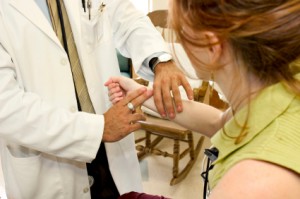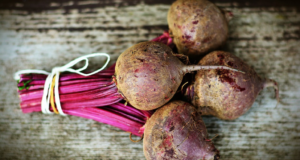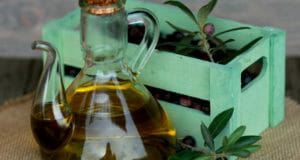Well, first of all, no one is recommending that you worry. True (at least in part) to the popular stereotype, stress can raise your blood pressure. Why is this a bad thing?
Blood Pressure is Inherently Volatile
 Exercise—for that matter, most activity—raises blood pressure in the short term. That is why you may get a high reading if you’ve rushed into the doctor’s office, and why a clinical blood pressure test may require up to five minutes of rest before the measurement is taken. As mentioned, stress also raises blood pressure, so you are likely to get higher readings when you are sick. All this is perfectly normal. Blood pressure, like heart rate, fluctuates according to circumstance. The key here is that the reading should return to normal once the activity is over or the stressor is removed. Normal is currently defined as below 120 mm Hg systolic and 80 mm Hg diastolic (120/80), where the two numbers measure pressure when the heart and arteries pump (systolic) and relax (diastolic), and “mm Hg” stands for millimeters of mercury, derived from the mechanics of early blood pressure measurement. Blood pressure is considered to be pathological—unhealthy and dangerous—when there are a series of high readings not attributable to other immediate causes.
Exercise—for that matter, most activity—raises blood pressure in the short term. That is why you may get a high reading if you’ve rushed into the doctor’s office, and why a clinical blood pressure test may require up to five minutes of rest before the measurement is taken. As mentioned, stress also raises blood pressure, so you are likely to get higher readings when you are sick. All this is perfectly normal. Blood pressure, like heart rate, fluctuates according to circumstance. The key here is that the reading should return to normal once the activity is over or the stressor is removed. Normal is currently defined as below 120 mm Hg systolic and 80 mm Hg diastolic (120/80), where the two numbers measure pressure when the heart and arteries pump (systolic) and relax (diastolic), and “mm Hg” stands for millimeters of mercury, derived from the mechanics of early blood pressure measurement. Blood pressure is considered to be pathological—unhealthy and dangerous—when there are a series of high readings not attributable to other immediate causes.
Getting Stuck on High
Chronic high blood pressure, also known as hypertension, continually stresses the arterial walls and the heart, causing them to work harder than they need to, and making them subject to thickening and a loss of elasticity. Although the long-term effects can be catastrophic, until something breaks down there are typically no symptoms at first. (Occasionally high blood pressure can be inferred from dizziness, headache and nosebleed.) Detected or not, the abnormally high pressure batters away at the circulation system for years, causing considerable damage before eventually creating the conditions for an enlarged heart, heart attack, stroke, brain hemorrhage, retinopathy, or kidney failure. An estimated third of U.S. adults who have high blood pressure don’t know it, but their ignorance does not prevent the ongoing damage.
The Usual Suspects
A few medical conditions, drugs, and herbs can bring on high blood pressure, accounting for under a tenth of all cases. Of the vast majority of instances with no single identifiable cause—“primary” or “essential” hypertension—some combination of the following risk factors is usually present:
- Weight. This is one of the few cases where mere weight or body mass index (BMI)—as distinct from excess body fat—can increase risk. Not only the flabby, but heavy-bodied, highly muscular athletes such as boxers, weight lifters and football linemen are at risk because the body produces more blood to keep all that body mass oxygenated, increasing the pressure on artery walls.
- A sedentary life. The less active the body is, the faster the heart rate tends to be, so the heart is working harder with every contraction.
- Tobacco and excess alcohol. Tobacco has its own damaging effects on arterial walls, making them subject to further stress. Alcohol in moderation seems to improve heart health, and in excess can be devastatingly damaging.
- High sodium, low potassium. These two electrolytes balance each other in the body. The modern high-salt diet has thrown that balance out of whack. Inadequate potassium intake may be implicated in heightened sodium sensitivity.
- Stress. Sustained stress—or a chronic pattern of stress responses to the ordinary vicissitudes of life—can elevate blood pressure long term.
- Age. Blood pressure tends to increase with age.
The Likely Fixes
Of course, with the exception of age, this list of risk factors more or less automatically suggests its own set of remedies and risk mitigations:
Lose weight. A loss of as little as five to ten pounds can significantly lower blood pressure. In some cases, athletes may have to rethink their activities and their goals away from those that build excess muscle mass.
- Get active. Debates continue over how much and what kind of exercise is healthiest, or necessary to avoid this or that medical condition. In the case of lowering blood pressure, the physical activity requirements are relatively modest. A half hour of aerobic activity most days of the week should suffice. The half hour needn’t be continuous—three bouts of ten minutes each works just as well—and aerobic activity is the kind that raises heart and breathing rates, but not to the point of making you short of breath (you should be able to talk without undue effort). Examples include active sports such as basketball, tennis, jogging, cycling, or swimming; brisk walking or climbing stairs; and the heavier household chores—lawn mowing, raking leaves, scrubbing the floor. Strength training can be part of the regimen, but may need moderation or modification.
- Lower sodium intake, and raise potassium if needed. Cutting back on sodium, including not just table salt but preserved meats and other prepared foods, helps keep your electrolytes balanced to optimize circulation health. So does adequate potassium intake (about 5 grams a day for adults), which is readily available from a diet that includes such sources as fresh meat, fish, soy, milk, yogurt, nuts, and a range of both fruits and vegetables. Lists of potassium-rich produce are readily available online, and healthware applications are available to both help with food logging for weight loss and counting micronutrients like potassium in your diet.
- Lower stress. Stress is a part of life. A sustained state of stress, though, can damage both body and mind. You may need to change your circumstances, change the way you react to your circumstances, and/or use stress-reduction techniques such as meditation or yoga.
What If These Methods Are Not Enough?
We cannot stress enough that high numbers are deadly. The potential remedies outlined above may not be enough to lower your blood pressure to safe levels. There is a range of standard pharmacological treatments whose efficacy and risks are reasonably well known. Apart from whatever decision you may make about medication with your doctor, the following have been shown in at least some clinical trials to reduce blood pressure.
The DASH and DASH-Sodium Diets
The DASH (Dietary Approaches to Stop Hypertension) diet is a star among dietary interventions, reducing high blood pressure within a couple of weeks. It comes with the blessing of the National Heart, Lung, and Blood Institute of the National Institutes of Health (NIH).
A typical meal (assuming three meals a day) on the DASH diet would look like something like:
- two servings of grains (e.g., ½ cup of cooked rice or pasta and a slice of bread, or two of each)
- 1-½ cups raw vegetables, or ¾ cup cooked
- 1-½ cups raw fruit, or ¾ cup cooked
- a cup of low-fat or non-fat dairy (not including high-sodium cheeses)
- three ounces or less of cooked meat, fish, poultry, or tofu
- a teaspoon of olive oil
Nuts, seeds and dry beans are limited to about a handful a day. Sweets are limited to 5 or fewer each week. Sodium is limited to either 2400 mg (about a teaspoon) a day, or 1500 mg daily—from all sources, including from processed and canned foods.
Herbs and Supplements
Herbs that have been shown to reduce blood pressure include the following:
- Garlic is demonstrably effective. It also has a blood thinning effect, so needs to be used cautiously if a person is taking other blood thinners.
- Milk thistle may also lower blood sugar. It is edible as a field vegetable, or can be used to brew tea.
- Hawthorn extract is available as a supplement, and the berries have been used in traditional Chinese medicine.
Herbs and herbals to avoid, since they raise blood pressure, are licorice, ephedra, Asian ginseng, and essential oil of rosemary.
Fish oil and perhaps particularly its docosahexaenoic acid (DHA) seems to modestly lower blood pressure.
Vitamins, Minerals, and CoQ10
Folate is a water-soluble B vitamin present in beef liver, leafy green vegetables, citrus fruits, and dried beans and peas. (Other foods may be “fortified” with its synthetic form, folic acid. Its role in preventing anemia is well understood. Its efficacy against high blood pressure can be significant, but may vary from one individual or group to another, based on other aspects of blood chemistry.
Calcium supplements seem to reduce blood pressure modestly but significantly; studies in this area are not definitive.
Studies on potassium supplementation have been equivocal, achieving some large reductions in blood pressure but not attaining statistical significance. The best approach to optimizing potassium, as discussed earlier, may be to get an adequate supply from food sources and reduce sodium intake.
Coenzyme Q10 (CoQ10) is a “vitamin-like substance” produced by the body. It declines with age, and its efficacy as a supplement is hotly debated. One of the best
demonstrations of its usefulness as a supplement is specifically in the area of reducing blood pressure, including dramatic reductions within twelve weeks in a small double-blind, placebo-controlled trial, using a divided dose of 120 mg daily.
Mindfulness Techniques
We’ve mentioned yoga, which can reduce stress and offers many other health benefits. Two other integrative or holistic techniques have been shown to be able to at least modestly reduce blood pressure:
Biofeedback focuses on monitoring and controlling involuntary somatic processes such as blood pressure, heart rate, muscle tension, and skin temperature. (It can also be applied to incontinence, chronic pain, migraine, and tension headaches, among other conditions.) Biofeedback is usually learned in a clinical setting where the feedback is delivered through electronic monitoring equipment; some of its techniques, however, can be exercised without the equipment. Somewhat counterintuitively, although direct feedback on blood pressure is available, feedback on temperature and electrical activity of the skin may be more helpful in blood pressure control.
Autogenic Training teaches techniques to control breathing, blood pressure, heart rate, and body temperature, processes normally handled by the body unconsciously. Six exercises can be learned from a teacher or by simply reading about them.
Learning to control your blood pressure through means that are available on grid or off may be more beneficial in the long-term than relying exclusively on prescription medication. In a TEOTWAWKI situation, prescription medication availability would be non-existent. You would need to have in place a system that would address your blood pressure needs without relying on modern conveniences. Find the balance of vitamins, supplements, herbs and other holistic techniques to control your blood pressure, and then stock up on those items you find works for you.
Other articles in this issue:
- Churn! Churn! Churn!
- Equal Taxation for All
- Why Monetizing Debt Leads To Higher Precious Metals Prices
If you liked this article you may be interested in this product from our sponsor.

 Off The Grid News Better Ideas For Off The Grid Living
Off The Grid News Better Ideas For Off The Grid Living



